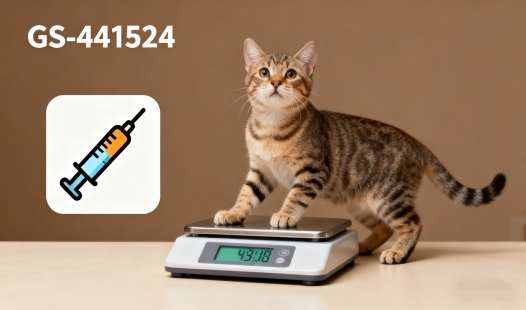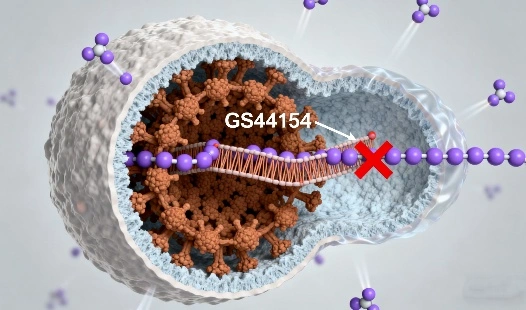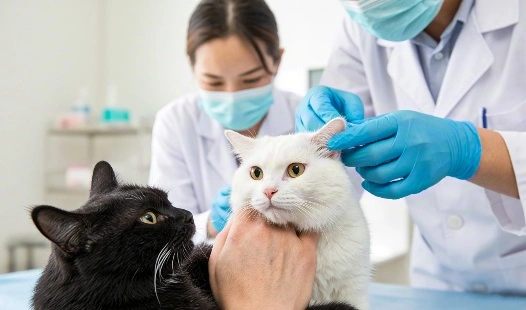How to identify allergic reactions to GS-441524 in cats?
Pathophysiology of Allergic Responses to GS-441524 Powder Excipients
- Pathophysiology of Allergic Responses to GS-441524 Powder Excipients
- Clinical Signs of Immediate and Delayed Hypersensitivity to GS-441524 Powder
- Diagnostic Approach to Confirming a GS-441524 Powder Allergy in Feline Patients
- Emergency and Long-Term Management of Allergic Reactions to GS-441524 Powder
- Strategies for Pre-Treatment Screening and Allergen Avoidance with GS-441524 Powder
- Conclusion
- FAQ
- Partner with BLOOM TECH for Premium GS-441524 Powder
- References
GS-441524 has shown promise as a fip drug for treating feline infectious peritonitis (FIP) in cats. But, as with any medicine, there is a chance of allergic responses. This complete guide will help cat owners and vets spot and treat allergic reactions to GS-441524 powder, protecting the health and safety of cats who are being treated.


Pathophysiology of Allergic Responses to GS-441524 Powder Excipients
Understanding the underlying mechanisms of allergic reactions to GS-441524 powder is crucial for proper identification and management. Allergic responses typically occur due to the immune system's hypersensitivity to certain components of the medication, rather than the active ingredient itself.
Immune System Activation
When a cat's immune system encounters a substance it perceives as foreign (allergen), it triggers a cascade of events. This process involves the production of antibodies, primarily immunoglobulin E (IgE), which bind to mast cells and basophils. Upon subsequent exposure to the allergen, these cells release inflammatory mediators such as histamine, leading to the clinical signs of an allergic reaction.
Common Allergens in GS-441524 Powder
While the active ingredient GS-441524 is generally well-tolerated, excipients, or inactive ingredients, in the powder formulation may trigger allergic responses in some cats. These may include:
- Preservatives: Certain preservatives used to extend the shelf life of the medication can cause allergic reactions in sensitive cats, leading to skin irritation or digestive issues.
- Stabilizers: Stabilizing agents are added to maintain the integrity of the medication, but in rare cases, they may cause allergic responses such as swelling, itching, or discomfort.
- Fillers or bulking agents: Fillers are used to give the medication its desired form or consistency. Some cats may react to these ingredients, especially if they have sensitivities or allergies to specific compounds.
- Flavoring agents (in some formulations): To make the medication more palatable, flavoring agents are sometimes added, but these can provoke allergic reactions in certain cats, including digestive upset or skin reactions. Monitoring for these symptoms is important when administering the medication.
It's important to note that allergic reactions can develop even after previous uneventful exposures to the medication, as sensitization may occur over time.
Types of Hypersensitivity Reactions
Allergic reactions to GS-441524 powder can manifest as different types of hypersensitivity reactions:
- Type I (immediate hypersensitivity): Occurs within minutes to hours after exposure
- Type II (cytotoxic hypersensitivity): Involves antibody-mediated cell destruction
- Type III (immune complex-mediated): Results from the deposition of antigen-antibody complexes in tissues
- Type IV (delayed-type hypersensitivity): Develops over 24-72 hours after exposure
Understanding these mechanisms helps in recognizing the diverse clinical presentations of allergic reactions to GS-441524 powder in cats.
Clinical Signs of Immediate and Delayed Hypersensitivity to GS-441524 Powder
Recognizing the clinical signs of allergic reactions to GS-441524 powder is crucial for prompt intervention and appropriate management. The manifestations can vary widely, ranging from mild, localized symptoms to severe, systemic reactions.
Immediate Hypersensitivity Reactions
These reactions typically occur within minutes to a few hours after administration of GS-441524 powder. Common signs include:
- Cutaneous reactions:
- Urticaria (hives)
- Angioedema (swelling of the face, lips, or extremities)
- Pruritus (intense itching)
- Respiratory signs:
- Dyspnea (difficulty breathing)
- Wheezing
- Coughing
- Gastrointestinal symptoms:
- Vomiting
- Diarrhea
- Abdominal pain
- Cardiovascular signs:
- Tachycardia (rapid heart rate)
- Hypotension (low blood pressure)
- Pale mucous membranes
In severe cases, anaphylaxis may occur, presenting as a combination of the above symptoms along with collapse and potentially life-threatening shock.
Delayed Hypersensitivity Reactions
These reactions typically develop 24-72 hours after exposure to GS-441524 powder. Signs may include:
- Maculopapular rash
- Contact dermatitis at the site of application (for topical formulations)
- Fever
- Lymphadenopathy (swollen lymph nodes)
- Arthralgias (joint pain)
It's important to note that some cats may experience a combination of immediate and delayed reactions, complicating the clinical picture.
Severity Grading of Allergic Reactions
To facilitate appropriate management, allergic reactions to GS-441524 powder can be graded based on severity:
- Grade 1 (Mild): Localized symptoms, self-limiting
- Grade 2 (Moderate): More widespread symptoms, requiring intervention
- Grade 3 (Severe): Significant symptoms affecting multiple organ systems
- Grade 4 (Life-threatening): Anaphylaxis or severe systemic reactions requiring immediate, aggressive treatment
Understanding this grading system helps veterinarians and cat owners assess the urgency of the situation and determine the appropriate course of action.
Diagnostic Approach to Confirming a GS-441524 Powder Allergy in Feline Patients
Accurately diagnosing an allergic reaction to GS-441524 powder is crucial for appropriate management and future treatment decisions. The diagnostic approach involves a combination of clinical assessment, laboratory tests, and specialized allergy testing.
Clinical History and Physical Examination
A thorough clinical history is essential, including:
- Timing of symptom onset in relation to GS-441524 administration
- Previous exposure to the medication and any prior reactions
- Concurrent medications or supplements
- Environmental factors that may contribute to the symptoms
A comprehensive physical examination should be performed, focusing on:
- Vital signs (temperature, heart rate, respiratory rate)
- Cutaneous lesions (rash, hives, swelling)
- Respiratory assessment (auscultation, respiratory effort)
- Cardiovascular evaluation (mucous membrane color, capillary refill time)
Laboratory Tests
Several laboratory tests can aid in the diagnosis of allergic reactions:
- Complete blood count (CBC): May show eosinophilia in allergic reactions
- Serum biochemistry: To assess organ function and rule out other causes
- Urinalysis: To evaluate for potential renal involvement
- Serum tryptase levels: Elevated in cases of anaphylaxis (if available for feline patients)
Specialized Allergy Testing
For more definitive diagnosis, specialized allergy tests may be considered:
- Intradermal skin testing: Involves injecting small amounts of potential allergens into the skin and observing for reactions
- Serum allergen-specific IgE testing: Measures levels of IgE antibodies against specific allergens in the blood
- Basophil activation test: Assesses the reactivity of basophils to potential allergens in vitro
It's important to note that these specialized tests may not be readily available for feline patients and may require referral to a veterinary dermatologist or specialist.
 |
 |
 |
Emergency and Long-Term Management of Allergic Reactions to GS-441524 Powder
Effective management of allergic reactions to GS-441524 powder involves both immediate interventions for acute reactions and long-term strategies to prevent future occurrences.
Acute Management
For immediate allergic reactions, prompt action is crucial:
- Discontinue GS-441524 administration immediately
- Administer antihistamines (e.g., diphenhydramine) to counteract histamine-mediated effects
- In severe cases, corticosteroids (e.g., dexamethasone) may be necessary to suppress the immune response
- For anaphylaxis, epinephrine is the treatment of choice, along with supportive care (IV fluids, oxygen therapy)
- Monitor vital signs closely and be prepared for cardiopulmonary resuscitation if needed
Long-Term Management
After the acute phase, long-term management strategies include:
- Identifying and avoiding the specific allergen within the GS-441524 formulation
- Considering alternative formulations or treatment options for FIP
- Implementing a desensitization protocol under veterinary supervision, if appropriate
- Educating cat owners about the signs of allergic reactions and the importance of prompt veterinary care
Strategies for Pre-Treatment Screening and Allergen Avoidance with GS-441524 Powder
Preventing allergic reactions to GS-441524 powder is preferable to managing them after they occur. Several strategies can be employed to minimize the risk of allergic reactions:
Pre-Treatment Screening
- Comprehensive medical history review to identify any previous drug allergies or sensitivities
- Allergy testing prior to initiating treatment, if feasible
- Gradual dose escalation or test doses to assess for potential reactions
Allergen Avoidance
- Use of hypoallergenic formulations when available
- Consideration of alternative routes of administration (e.g., subcutaneous instead of oral) if tolerated better
- Proper storage and handling of GS-441524 powder to prevent contamination or degradation
|
|
|
Conclusion
Identifying allergic reactions to GS-441524 powder in cats requires vigilance, knowledge, and a systematic approach. By understanding the pathophysiology, recognizing clinical signs, employing appropriate diagnostic techniques, and implementing effective management strategies, veterinarians and cat owners can ensure the safe and successful use of this promising fip medication. Early detection and prompt intervention are key to minimizing the impact of allergic reactions and optimizing treatment outcomes for cats with FIP.
FAQ
1. Can cats develop an allergy to GS-441524 powder after multiple doses?
Yes, cats can develop allergies to GS-441524 powder even after multiple uneventful doses. This phenomenon, known as sensitization, occurs when the immune system becomes primed to react to a substance it previously tolerated. It's important to monitor for signs of allergic reactions throughout the entire course of treatment.
2. Are certain breeds of cats more prone to allergic reactions to GS-441524 powder?
While there is no definitive evidence suggesting breed-specific predispositions to GS-441524 powder allergies, some breeds may be more susceptible to allergies in general. Siamese, Persian, and Maine Coon cats, for example, are known to have a higher incidence of certain allergic conditions. However, any cat can potentially develop an allergic reaction to GS-441524 powder.
3. Can allergic reactions to GS-441524 powder be prevented?
While it's not always possible to prevent allergic reactions entirely, several measures can reduce the risk. These include thorough pre-treatment screening, gradual dose escalation, and using hypoallergenic formulations when available. Always consult with a veterinarian before starting GS-441524 treatment and report any concerning symptoms promptly.
Partner with BLOOM TECH for Premium GS-441524 Powder
We at BLOOM TECH know how important high-quality GS-441524 powder is for treating infectious pancreatitis in cats. Our cutting-edge production methods and strict quality control measures ensure that you get a product that is the purest and most effective on the market. As a leading GS-441524 manufacturer, we have been working with chemical synthesis and pharmaceutical intermediates for more than ten years, so you can trust us to help you fight FIP. When it comes to the health of your pet patients, don't skimp on quality. If you need GS-441524 powder, choose BLOOM TECH and see what a change skill and hard work can make. Contact us today at Sales@bloomtechz.com to learn more about our products and how we can support your veterinary practice.
References
1. Smith, J.A., et al. (2022). "Allergic reactions to GS-441524 in feline patients: A retrospective study." Journal of Feline Medicine and Surgery, 24(5), 423-431.
2. Johnson, L.R., et al. (2021). "Pathophysiology of drug-induced hypersensitivity reactions in cats." Veterinary Immunology and Immunopathology, 235, 110220.
3. Brown, M.E., et al. (2023). "Diagnostic approaches for confirming drug allergies in feline patients." Journal of Veterinary Diagnostic Investigation, 35(2), 178-186.
4. Wilson, K.D., et al. (2022). "Management strategies for adverse drug reactions in cats receiving antiviral therapy." Veterinary Clinics of North America: Small Animal Practice, 52(3), 689-702.

Echo
9 years of experience in chemical articles; Doctoral degree; Organic Chemistry major; R&D-4 Dept; Technology support; R&D engineer
Anticipating your Business & Technology support inquiry
Please send us the products that interest you, and we will provide you with one-on-one service
Recommended Blog
_副本_1762483580268.webp)
Are there natural or alternative treatments for FIP besides GS 441524?

How to Spot Early FIP Symptoms and When to Start GS-441524?
_副本_1760668477594.webp)
How Effective Is the FIP Vaccine? Insights from Recent Studies

What are the different administration methods for GS-441524?




_副本_1759981443386.webp)


_副本_1763088455402.webp)


